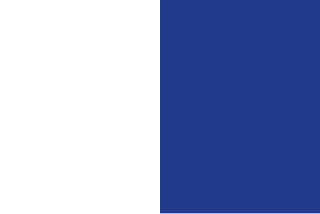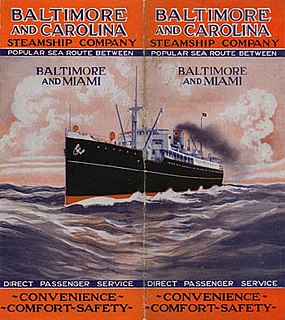Related Research Articles
SS Tropic was a steamship operated by the White Star Line. Built in 1871 by shipbuilders Thos. Royden & Co, the 2,122 gross register ton vessel operated on the Liverpool to Calcutta run in 1871, and in 1872 began serving South American ports from Liverpool. In 1873, the ship was sold to Serra y Font, Bilbao, and renamed Federico. She was operated by the white star line. She served alongside her sister ship, RMS Asiatic.
SS Asiatic was a steamship operated by the White Star Line from 1871 to 1873, a sister ship to Tropic. Sold off after only two years, she was renamed SS Ambriz, and eventually was wrecked in 1903.

The Type C4-class ship were the largest cargo ships built by the United States Maritime Commission (MARCOM) during World War II. The design was originally developed for the American-Hawaiian Lines in 1941, but in late 1941 the plans were taken over by the MARCOM.
Lesbian was a 1,559 GRT cargo liner which was built by Thomas Royden & Sons Ltd., Liverpool. She was launched in 1874 and scrapped in 1903.
The SS Alesia was a 2,790 GRT ocean liner built for the Fabre Line in 1882. It served until 1899 when she was scrapped.

SS Doric was a British ocean liner operated by White Star Line. She was put into service in 1883. Built by the Harland and Wolff shipyards in Belfast, she was the sister ship of the Ionic which was put into service a few months earlier. Although the original purpose of the construction of the two ships was not known with certainty, both began their careers chartered by the New Zealand Shipping Co. which operated them on the route from London to Wellington.

Harrison Line, officially T&J Harrison, was a shipping line founded by the brothers Thomas and James Harrison in Liverpool, England in 1853. It ran both cargo and passenger services, starting with the import of French brandy from Charente.
SS Ionic was a cargo liner initially in service with White Star Line from 1883 until 1900. She was used on the company's joint route to New Zealand with the Shaw, Savill & Albion Line. She was sold to the Aberdeen Line in 1900 and renamed SS Sophocles, and was withdrawn for service in 1906 and scrapped in 1908.

Port Line was a passenger and cargo shipping company, initially formed as the Commonwealth and Dominion Line in 1914, and in operation in one form or another until 1982.
The Type C7 ship(Lancer Class) is a United States Maritime Administration (MARAD) designation for a cargo ship and the first US purpose-built container ship. The vessels were constructed in US shipyards and entered service starting in 1968. As US-built ships they were Jones Act qualified for shipments between US domestic ports. Under the Jones Act domestic US maritime trade is restricted to US-built and flagged vessels of US owners and manned by predominantly US-citizen crews. The last active Lancer container-configured ship was scrapped in 2019. Lancers of the vehicle Roll-on/Roll-off (RO/RO) configuration remain held in the Ready Reserve Force, National Defense Reserve Fleet and the US Navy Military Sealift Command. All are steam powered.
SS Aleppo was a British passenger cargo vessel, launched on 1 November 1864, measuring 292.5 feet by 38.2 feet, 2,057 gross tonnage, built in Glasgow by J & G Thomson, Govan. She made her first North Atlantic voyage from Liverpool to Halifax to New York City beginning on 15 September 1865. The Aleppo had accommodation for 46 first class and 593 third class passengers. The ship was commissioned for the British & Foreign Steam Navigation Company, Glasgow, a company established in 1855 to run the Mediterranean shipping interests of the investors of the British and North American Royal Mail Steam-Packet Company, the forerunner of the Cunard Line. In 1878 the firms were reorganised, the British & Foreign Steam Navigation Company and its ships were merged into the Cunard Steam Ship Co. Ltd., and Aleppo was transferred on 7 September 1878.
The Delphic was a British freighter operated by the White Star Line, the company's second ship to bear this name. She was built by the Harland & Wolff shipyards in 1916 to serve the war effort under the name of War Icarus, belonging to the series of "Type G" cargo ships. Launched in September 1918 and commissioned in the following October, she was the only ship in the series to be completed before the end of the First World War. During this time, she was operated by a Liverpool company.
Lamport and Holt was a UK merchant shipping line. It was founded as a partnership in 1845, reconstituted as a limited company in 1911 and ceased trading in 1991.

The Brocklebank Line was an English shipping line that operated in the 19th and 20th centuries.
Mississippi Shipping Company of New Orleans, Louisiana was a passenger and cargo steamship company founded in 1919. In 1961 officially changed its name to the Delta Line. The Mississippi Shipping Co. serviced port from the Gulf of Mexico and east coast of South America. The Mississippi Shipping Co. was formed to support coffee merchants and Brazilian produce to New Orleans and up the Mississippi River. competing with the New York City trade. Delta Line failed to upgrade to container ships and modernize as other shipping lines did in the 1970s. In 1982 Delta Line, now owned by the Holiday Inn Corporation sold the line to Crowley Maritime. Crowley was the largest US barge and tugboat operator at the time. Crowley started to modernize the ships on the route, but sold the shipping line to the United States Lines in 1985. United States Lines brought some of the ships into its routes but went bankrupt in 1986. At its peak in 1949, the Mississippi-Delta line owned 14 ships at a total of 98,000 grt. Delta Line also moved into passenger cruise with to ship. During World War II the Mississippi Shipping Company was active with charter shipping with the Maritime Commission and War Shipping Administration. During wartime, the Mississippi Shipping Company operated Victory ships, Liberty shipss, and a few Empire ships.
Pacific Far East Line, also called PFEL in short, was a passenger and cargo shipping line founded in 1943 by Thomas E. Cuffe, in San Francisco, California. At the beginning he started by chartering foreign ships to run the lines in tramp trade. Later scheduled cargo services were added to the line. During World War II the South Atlantic steamship line was active with charter shipping with the Maritime Commission and War Shipping Administration.

Agwilines Inc was a passenger and cargo shipping company of New York City. Agwilines is short for Atlantic, Gulf & West Indies Steamship Inc. AGWI Lines group operated four main lines in the 1910s, 1920s and 1930s:

A. H. Bull Steamship Company was a shipping company and passenger liner service founded in New York City in 1902 by Archibald H. Bull (1848-1920). Service started with shipping between New York and Florida. His fleet of ships then added service to other Eastcoast ports. The company is also often called the Bull Lines and the Bull Steamship Line or A. H. Bull & Company. While founded in New York, Bull soon move its headquarter to Peir 5 in Baltimore, Maryland. Bull Lines main Eastcoast ports were: Baltimore, Charleston, Philadelphia, Tampa and Norfolk, Virginia. Oversea ports: Porto Rico, Antwerp, Bordeaux, Hamburg, Bremen, Copenhagen, and West Africa. Bull Steamship Line supported the US war effort for both World War I and World War II, including the loss of ships.
References
- ↑ Wakefield, W. Heaton (1931). "A Brief History of Thos. Royden & Sons". royden.com. Royden & Sons. Retrieved 31 October 2012.
- ↑ Royden, Mike (2010). "Royden Family History Pages – The Roydens of Frankby". roydenhistory.co.uk. Retrieved 31 October 2012.
- ↑ "Thos. B. Royden & Co". The Merchant Navy Association. 2010. Archived from the original on 5 February 2012. Retrieved 31 October 2012.